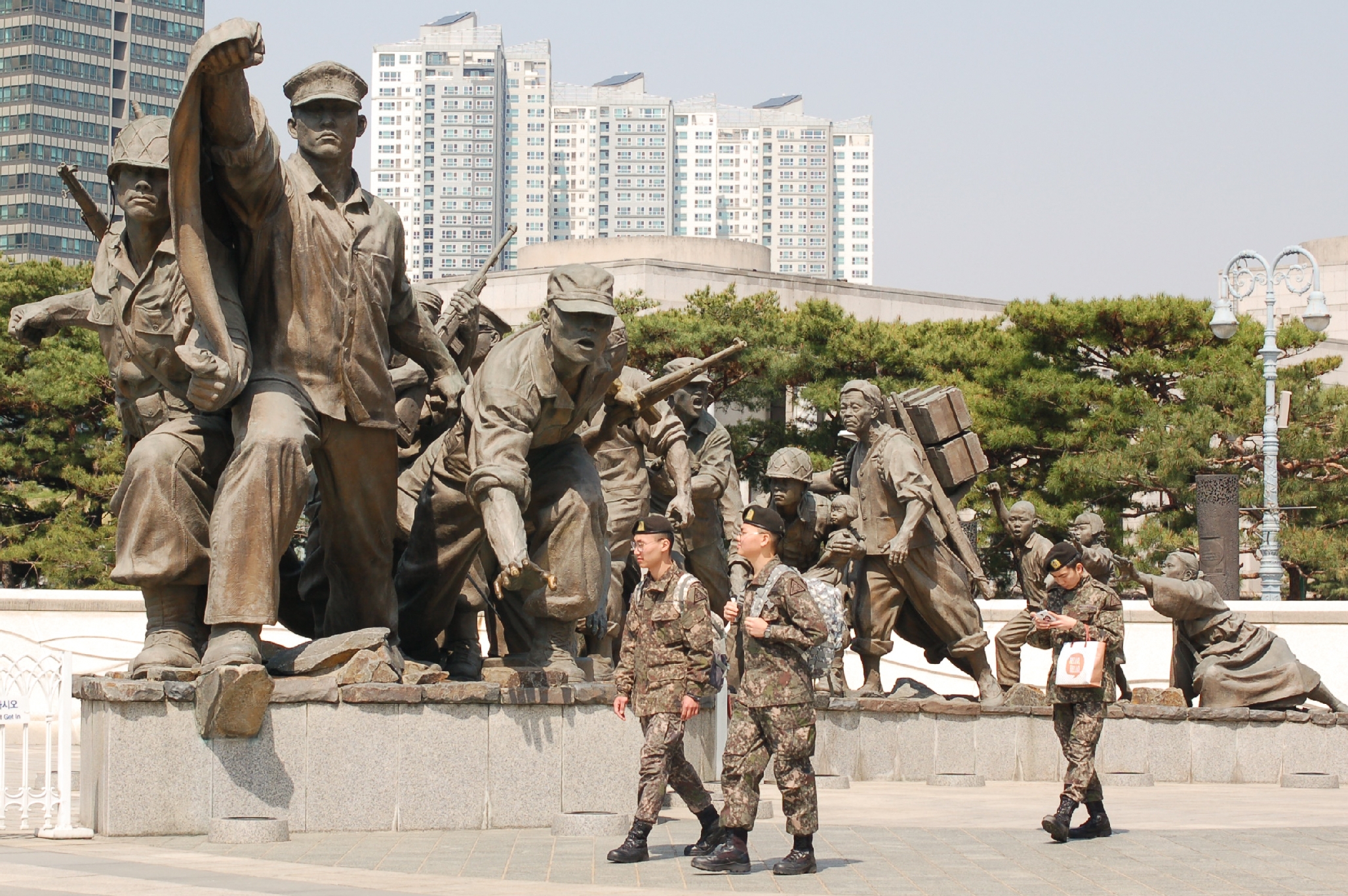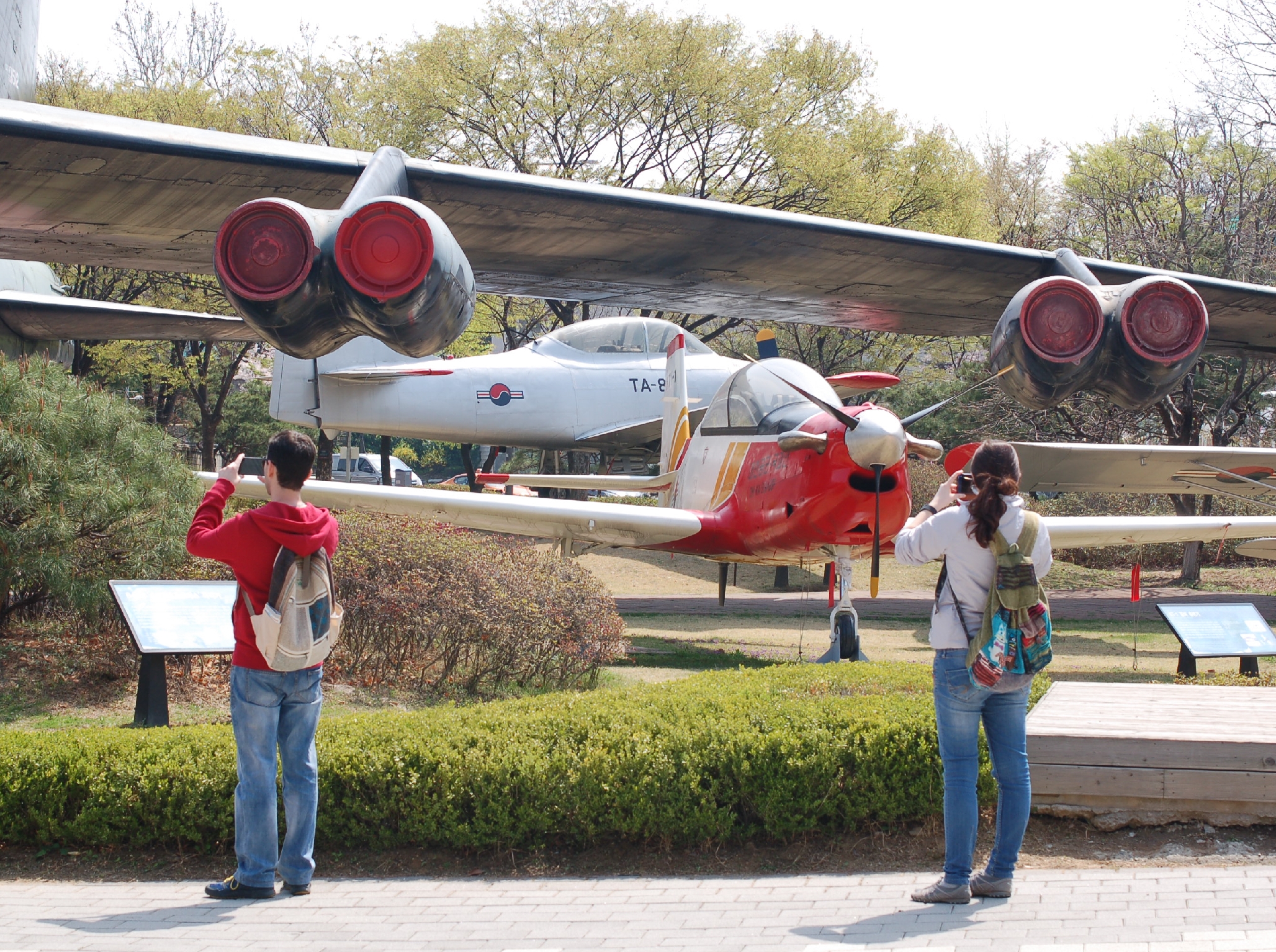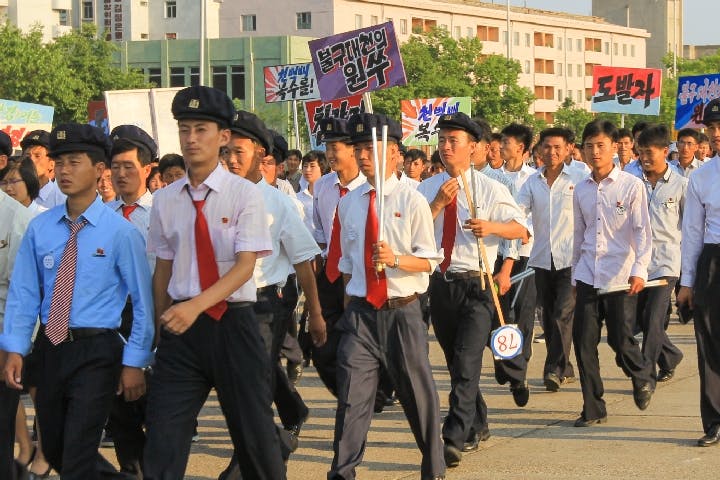Spring 2017
For North Koreans, the War Never Ended
– Jean H. Lee
North Korea portrays Americans as masters of torture to reinforce its leaders’ desire to keep the war alive. That certainly hasn't changed in the early days of the Trump administration.
Most North Korean children have never seen an American in person. But they get an eyeful of them at a massive museum in the town of Sinchon that is devoted to educating them on U.S.-North Korean history.
It’s not baseball and apple pie here. At the ominously named Sinchon Museum of American War Atrocities, Americans are a sinister lot: scheming missionaries, marauding soldiers, and masters of torture. This is a museum in a farming town south of Pyongyang that has been rebuilt as a mecca to anti-Americanism. All spring and summer, North Korean schoolchildren will be making field trips here to cement what is an integral part of their education: hatred of the United States military and a mission to seek revenge.
For North Koreans, the 1950–53 Korean War that pitted the North Koreans and Chinese against U.S.-led United Nations troops — known in Pyongyang as the Fatherland Liberation War — remains in full tilt. The two sides may have signed a ceasefire in 1953, but the war still looms large in the North Korean psyche.
Understanding how North Korea sees the United States is integral to divining how to change the tenor of the tense U.S.–North Korea relationship, which persistently threatens to erupt again into military conflict.
We in the United States often call the Korean conflict the “Forgotten War.” My high school history textbook in Minnesota devoted barely a paragraph to it, and growing up as the child of Korean immigrants, I knew almost nothing about a war my own parents survived as children. But the war is very much alive and present in North Korea, and the standoff with the United States figures prominently in their propaganda, identity, and policy. Understanding how North Korea sees the United States is integral to divining how to change the tenor of the tense U.S.–North Korea relationship, which persistently threatens to erupt again into military conflict.
The arrival of a new president, a Republican, in Washington after eight years of a Democrat in the White House means that there is an opening for change. How best to take advantage of that opening, however, is a tricky question when 25 years of U.S. bids to negotiate with North Korea have not stopped Pyongyang from building nuclear weapons. The North Koreans have been waiting and watching to see what the Trump administration comes up with. But Pyongyang’s patience will be limited.

An opening for change
In November 2008, as the Associated Press news agency’s Seoul bureau chief, I made my first trip to North Korea just weeks after Barack Obama won the U.S. presidential election. Knowing that I was a journalist, and no doubt instructed to pump me for information about the president-elect, our North Korean tour guide latched onto me and grilled me: What did Obama think about North Korea? Would he be open to meeting the leader of North Korea?
During his presidential campaign, Obama had suggested he would be open to engaging North Korea if the situation were right, an interpretation that I relayed to the North Korean guide. But just months into Obama’s presidency, North Korea launched a banned long-range rocket and followed that up by testing a nuclear device, making it difficult for the U.S. administration to do anything but lead the chorus of international condemnation of Pyongyang for its defiance of UN Security Council resolutions explicitly barring such activity.
Washington tends to look at North Korea’s behavior solely from the view of the message Pyongyang is trying to tell America. But at the time, in April 2009, Pyongyang had reason at home for staging such theatrical provocations: then-leader Kim Jong Il had emerged from a coma and had just made his first public appearance after months of speculation about his health and North Korea’s stability. The regime needed something big to reassure the people that the republic was intact, and still feisty, and that Kim was able to defend them against the United States.
North Korea systematically uses the fear of an outside threat to spur and inspire national pride and unity. And often, that need to rally the people in order to ensure stability outweighs any advances that North Korea’s diplomats have made in repairing relations with the United States.
In December 2011, I reported exclusively that North Korea and the United States were negotiating a groundbreaking deal that promised food and aid in exchange for a freeze of Pyongyang’s nuclear program. The news hit the wire as Kim Jong Il lay dead from a heart attack, unbeknownst to me and the rest of the world. Kim Jong Il’s death was announced the next day as I was en route to North Korea to open the AP’s new Pyongyang bureau, a project I was told that Kim had personally approved. Some read North Korea’s willingness to allow the U.S.-based news agency into Pyongyang as a sign of new openness toward Washington.
His death, and the rise of his young son, Kim Jong Un as leader, seemed to offer another chance at changing the tone of the relationship. Two months later, on February 29, 2012, envoys from Pyongyang and Washington signed a pact on restrictions on North Korea’s missile development programs that became known as the Leap Day Deal. But it was only a matter of weeks when, as part of celebrations marking the centenary of the birth of his late grandfather, President Kim Il Sung, North Korea launched a long-range rocket in bold defiance of the United States and their Leap Day Deal — not to mention the UN and the Security Council’s ban on rocket activity considered to be a test of missile technology.
The Obama administration eventually adopted a policy of “strategic patience” on North Korea, refusing to get riled up by Pyongyang’s rhetoric and avoiding overtures that would appear to reward bad behavior. The aim was to discourage North Korea from using provocations as a bartering chip. Meanwhile, the U.S. Treasury Department turned the screws on the North Koreans with a series of increasingly specific sanctions aimed at thwarting its ability to build bombs and missiles and putting a financial pinch on members of the party elite. But bomb-making materials continued to slip through China’s porous border into the country, and the missile test-launches and nuclear tests continued — at a much faster pace with Kim Jong Un in power than ever before.

Trump on North Korea
During his 2016 presidential campaign, Trump suggested that he would take a very different approach on North Korea. “I would speak to him,” he told Reuters that May.
That certainly got the apparatchiks’ attention in Pyongyang.
In 1994, Kim Il Sung met with former U.S. President Jimmy Carter at the height of a nuclear crisis. And Kim Jong Il managed to sit down with Bill Clinton in 2009 when the former U.S. president flew to Pyongyang to negotiate the release of two American journalists. However, no sitting U.S. president has held a summit with a North Korean leader, and the optics of an American head of state shaking hands with Kim Jong Un would be propaganda gold for the North Koreans. That would be the antithesis of strategic patience, and the North Koreans relished the notion. For four months, there were no missile or nuclear tests in North Korea.
Meanwhile, Trump’s campaign comments worried South Koreans, who do not want to be left out of decisions relating to the North. After all, they have the most to lose if the “thermonuclear” war that the North Koreans threaten breaks out. Many South Koreans also bristled at Trump’s campaign characterizations of their country as a rich nation that is freeloading off the United States in trade and military support. But South Koreans were also preoccupied by political upheaval at home: a corruption investigation reaching the presidential Blue House and top corporations; months of protests in downtown Seoul; the impeachment of President Park Geun-hye; and campaigning in advance of a snap election set for early May.
Since taking office, President Trump has reaffirmed the longstanding U.S.–South Korean alliance. He has taken a tougher approach on North Korea, with his secretary of state, Rex Tillerson, saying, “All options are on the table” — including military strikes. On April 7, Trump ordered an airstrike on a Syrian airfield, which Tillerson said was meant to send a strong message to America’s adversaries, including North Korea. That shift in attitude has won over conservatives in South Korea. However, with progressive Moon Jae-in winning the May 9 elections in a landslide, South Korea now has a leader who advocates engagement with the North. Having a liberal government in the Blue House after nearly 10 years of a conservative administration will prompt a shift in alliances and policy across the region.
Those of us who watch North Korea knew there was a narrow window of opportunity — and that this young man who rules the nation is not a paragon of patience. When Kim vowed on New Year’s Day to perfect a ballistic missile designed to strike the mainland United States, Trump blasted back with a tweet: “Won’t happen!” Three weeks later, the North Koreans fired off a warning salvo — a test-launch of a new intermediate-range ballistic missile — just as Trump was sitting down with Japanese Prime Minister Shinzo Abe. A series of missile tests has followed, and satellite imagery suggests North Korea may be poised to detonate another nuclear device underground.
Kim Jong Un clearly is enjoying having these big guns at his disposal — and is basking in the show of strength the missiles and nuclear weapons provide. Garnering global attention is part of the strategy. Is he truly willing to get rid of the one “treasured sword,” as state media calls the nuclear program, that has been so useful in pulling the country together? Without nuclear weapons and the pretext of defense, North Korea would have to rely on its own economy to keep the country intact.
Instead of setting the stage for improved relations, North Korea has imprisoned two Americans on espionage and anti-state charges. Kim has also poured resources into amping up the propaganda against the Americans, suggesting that hatred of the United States would become an even bigger part of North Korean education and policy.

An anti-American house of horrors
North Korea needs an enemy. The regime needs a villain for its people to hate. There is no indication that the regime will let go of that hatred anytime soon.
The museum in Sinchon is a prime example. Tucked down a street in south Hwanghae Province, the original museum was created to serve as a repository of alleged American atrocities. Plain and unassuming, the old building housing the relics was flanked by massive mosaics that hinted at the anger contained within: a grandmother in traditional dress, hair askew, shaking her fist at the “wily Americans” and calling on fellow North Koreans to seek “a thousandfold revenge.”
Inside, room after room catalogued the alleged war crimes committed by Americans, from the Presbyterian missionaries accused of seeking to brainwash Koreans with religion to the “Hitlerite” American soldiers they claim systematically tried to exterminate the townspeople in the early months of the Korean War. Display cases offered what they called proof: some 3,000 artifacts dug up from the soil, including skulls, bones, ID cards, simple woven shoes. A 2009 book on the museum published by Pyongyang’s Foreign Languages Publishing House says that more than 35,000 people, a quarter of the county’s population, were killed during a 52-day rampage.
After a 2014 visit to Sinchon, Kim Jong Un called for an upgrade. The simple building on a grassy knoll was replaced by a palatial museum that is a veritable house of horrors, with room after room graphically bringing to life the gruesome atrocities attributed to the Americans. The renovated museum opened in late July 2016, in time for the anniversary of the Korean War ceasefire (which the North Koreans call “Victory Day,” even though the fighting ended in a truce).
A visit there is like walking through the set of a horror movie; visitors can walk right up to the tableaus and can practically smell the blood and hear the screams. In one tableau shown in photos published by Pyongyang’s official Korean Central News Agency in July 2016, a life-sized American soldier yanks the hair of a young Korean woman tied to a tree as another American sinks a knife into her heart. In another room, suffused in red light as though drenched with blood, American soldiers drive nails into a Korean woman’s head. Rabid glee distorts their faces.
The grisly scenes are meant to be lifelike. But are they accurate? Many in South Korea and the United States question the veracity of the claims that such killings were carried out by American troops. While the bones and personal artifacts appear genuine, on my own visits to the museum I did not see any items that directly proved or implicated American involvement.
With few, if any, formal challenges to the claims, North Korea has forged ahead in attributing the deaths to the “American imperialists.” In a 2010 North Korean book called The Sinful American Aggressors’ Imperialism of Korea, a grainy, black-and-white photo is characterized as showing one American solider scrawling the phrase “I can’t sleep without killing” in a notebook. “The Americans are slaughterers who brutally massacred our people,” the book informs the reader over 308 pages of unattributed allegations.
“American bastards”
Throughout my visits to the Sinchon Museum, our North Korean guide repeatedly referred to Americans as miguk nom, or “American bastards.” He knew I was American, but did not even blink in using this epithet to my face in nearly every sentence he spoke. Because I am an ethnic Korean and did not look anything like the blond scarecrows depicted on the walls of the museum, I did not appear “American” to him, and the slur was never meant to offend me. The phrase is simply so fixed in his mind that the two words are inextricable.
However, the North Koreans I met in the street loved meeting Americans. Whenever they spotted my non-Korean colleagues, the children called out, “Hello, how are you? Hello, how are you?” They were always excited to practice their English, and usually more curious than scared of the foreigners in their presence. Like children everywhere, they loved America’s cultural exports, Winnie the Pooh and Snoopy, in particular.
In my years traveling to North Korea, almost never did I hear a North Korean refer to an “American” without automatically attaching the word “bastard” to it. It was a constant reminder of the psychologically rooted hatred of the United States that remains so deeply entrenched in the North Koreans’ education, culture, and ideology — even if what they crave is a chance to sit at the table with the Americans.
Jean H. Lee (@newsjean) is a Seoul-based global fellow with the Wilson Center. In 2011, she became the first American journalist granted permission to join the local foreign press corps in North Korea.
Dasl Yoon contributed to this article from Seoul.
